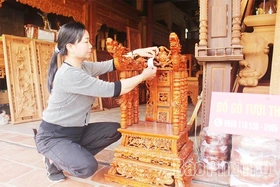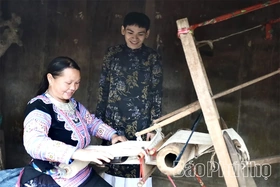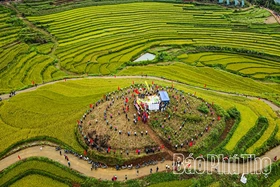{title}
{publish}
{head}
The traditional art of creating skirt patterns among the Muong people, originally in Hoa Binh province, now part of Phu Tho province, has been officially recognized by the Ministry of Culture, Sports, and Tourism as a National Intangible Cultural Heritage. This honor serves as a source of pride for the Muong community and motivates continued preservation and promotion of this unique cultural expression.
A distinctive craft rooted in tradition
Historically, the Muong community in Hoa Binh lived in close connection with agricultural production and a self-sufficient economy, where traditional crafts, particularly weaving, played a central role. The traditional costume of Muong women consists of an ao pan (tunic), bib, skirt, tenh (waistband), and headscarf. Among these, the skirt stands out as the cultural centerpiece, with the technique of pattern-making determining its overall value.

Muong women at the weaving loom.
The waistband of a Muong woman’s traditional costume is discreet yet striking in its sophistication. The patterns woven into the waistband are what give the costume its distinctive value. As noted by folklorist Tu Chi, “They do not carve on wood, stone, pottery, or metal; they do not sculpt wooden or stone statues, nor mold clay or cast bronze-but they weave their aesthetic philosophy into women’s waistbands! The waistband here is like a statue, like a painting!”
To fully appreciate the artistry of Muong brocade, one must observe it closely. A traditional waistband consists of three sections arranged vertically: the upper band, the lower band, and the top edge.
The upper band features geometric designs symbolizing various forms of the sun, arranged horizontally. These motifs often include overlapping diagonal squares and nested concentric squares.
The lower band is considered the most important section, showcasing motifs inspired by animals and plants interwoven with geometric decorations. Creating this intricate part typically requires a specialized loom system with dozens of pattern-specific heddles.
The top edge usually includes alternating stripes of yellow, blue, and red, accented with subtle patterns.

Patterns on the Muong skirt’s waistband.
Weaving is a craft that demands patience, precision, dexterity, and a deep sense of aesthetics. Creating a waistband involves four main stages: preparing the fabric, winding it onto the shaft, picking the patterns, and weaving. Of these, picking the pattern is the most complex, requiring both accuracy and spatial imagination. Each motif calls for a distinct loom system to hold the threads in place. The weaver then follows a memorized sequence, guided by both eye and hand. Depending on the complexity, a single waistband may involve 40 to 50 pattern heddles.
Color selection is equally deliberate. While white and black are commonly used, other hues such as blue, red, yellow, brown, and indigo are also featured. The dyeing process is itself an art form. The Muong people traditionally use natural methods to create long-lasting colors, red, for example, is made from boiled phang tree bark, combined with crushed ant wings to deepen the shade. Yellow is derived from co hem tree bark, pui bark, vang fruit, or turmeric.
The language of patterns
The true value of a Muong waistband lies in its rich pattern system, which is both decorative and symbolic. These motifs reflect the community’s worldview, aesthetic values, and aspirations for happiness and prosperity. Each pattern carries its own meaning.

Muong women in traditional costumes.
In Muong beliefs, dragon and phoenix patterns symbolize strength and nobility and were often worn by members of the Lang (chieftain) family. The dragon also represents the water element, an essential force in the agricultural life of the Muong. Bird motifs symbolize care and respect; deer signify friendship and kindness. The tlang flower embodies the love between husband and wife, while sim flowers represent loyalty. The pure white grapefruit blossom is a symbol of feminine purity.
Bui Van Nam, an officer of the Department of Culture, Sports, and Tourism and a passionate advocate of Muong culture, shared, “What’s special is that many waistband patterns are also found on Dong Son bronze drums. This demonstrates that the skirt patterns of the Muong not only have artistic value but also historical significance, connected to a glorious era of Vietnamese civilization.”
Preserving a living heritage
The art of creating skirt patterns has long been passed down by Muong women, who are both the creators and custodians of this cultural legacy. Girls begin learning how to spin and weave as early as age five or six, and by nine or ten, they are taught to craft skirt patterns. Nearly every Muong girl is able to make her own traditional costume to wear at weddings, festivals, and other significant events.

Foreign tourists enjoy the experience of wearing traditional Muong costumes.
However, in today’s fast-paced world, this heritage faces the risk of fading away. The number of people who can weave traditional waistbands is declining, most of them are elderly. Industrial fabrics and synthetic dyes are gradually replacing handmade garments and natural materials.
To address this challenge, the province has introduced several initiatives to safeguard and promote the craft. These include policy support for artisans, training programs, and cultural events such as costume showcases tied to festivals and community-based tourism.
One notable example is Thanh Cong Cooperative (HTX) in Thong Nhat Ward, which has launched a weaving and tailoring workshop specializing in ethnic costumes. Equipped with 10 looms and 10 skilled artisans, the workshop produces about 550 meters of fabric per month. Members like Ms. Quach Thi Hien and Ms. Phung Thi Tiep are local residents with deep knowledge of Muong traditions. According to Ms. Quach Thi Dung, the cooperative’s manager, “Initially, we had just seven members; now the number has grown to 20. Beyond preserving heritage, we’ve also created employment opportunities for around 40 seasonal workers.”
The art of creating skirt patterns is not only a fundamental element of Muong culture but also a repository of indigenous knowledge, a living heritage that encapsulates ethnic identity. Preserving and promoting this tradition is, in essence, preserving the national soul in an era of cultural integration.
Cam Le

baophutho.vn On December 8, 2017, at its 12th session, the UNESCO Intergovernmental Committee for the Safeguarding of Intangible Cultural Heritage...

baophutho.vn Situated in the fertile land of Binh Nguyen (Vinh Phuc), the Huong Canh Communal House Complex — comprising Huong Canh, Ngoc Canh and Tien...

baophutho.vn For generations, whenever people mention Huong Canh Town (former Binh Xuyen District, Vinh Phuc Province), now Binh Nguyen Commune of Phu Tho...

baophutho.vn Kha Cuu Commune was formed by merging three former communes: Dong Cuu, Thuong Cuu, and Kha Cuu, with the Muong ethnic group accounting for over...

baophutho.vn Perched atop Tram Linh Hill, Quoc Te Temple in the former Di Nau Commune — now Tho Van Commune — has long been regarded as a solemn and...

baophutho.vn Located in Giap Lai Commune, this ancient communal house is revered by local residents as the “soul of the Muong village.” It is dedicated to...

baophutho.vn The Thai people are the largest indigenous ethnic group in Mai Chau District, now residing mainly in communes such as Mai Chau, Bao La, Mai Ha,...

baophutho.vn Today, Phu Tho Province is home to hundreds of traditional craft villages — from wood carving, blacksmithing, and bamboo weaving to mechanics,...

baophutho.vn In line with the orientation toward tourism-based economic development, the traditional brocade weaving craft of the Mong ethnic group in Pa Co...

baophutho.vn On the morning of October 25, the opening ceremony of the Mien Doi Terraced Fields Festival 2025 took place in Thuong Coc Commune.